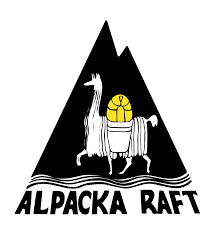Commercial whitewater rafting in Washington State is almost exclusively done by guides running straight paddle rafts; that is, there are no frames or oars involved. As often as we have guests on our trips that haven’t been rafting before, we have guests who call paddles oars, and oars paddles. The distinction is simple; a paddle is a hand held propulsion device using human power. It is identified by three characteristics; the blade (the part that paddles the water), the t-grip (the noticeably “T” shaped handle at the end, so designed to take pressure off of the wrist during the paddling motion), and the shaft (the long, typically cylindrical bar holding the blade to the t-grip). Paddles are effective at propulsion as a raft can be propelled by making a stabbing motion into the river with them, and pulling back on it to propel the raft forward (in this case); paddling. Paddles are often plastic, or an aluminum core coated in plastic (to help avoid injury and unnecessary cold hands from bare metal. Higher end paddles, or paddles that are used by professional guides and racing teams are almost exclusively some kind of carbon fiber/fiberglass composite, and yet others, used by the purists of our sport, are made of wood.
There are several different types of oars. Oars are longer, usually twice as long for the same task, twice as thick, and have larger blades. Oars are best used with a fulcrum point somewhere near the middle of the shaft of the oar, but often between 25-50% down the shaft, closer to the handles. An important distinction should be made here before we move too much further; oars are a noun, a “thing” as it were, and there is no verb for “oaring”, despite how many rookie guides want to be professional “oarers”. This word simply does not exist in the professional guides nomenclature; while we have several slang terms that make little to no sense to the general public, there are certain proverbial misgivings that we cannot abide in our profession, and this word is one of them. You row a boat, simply put, and the person who does the rowing can be an “oarsman, oarsperson, oarswoman”, a “boatman, boatwoman, boatperson”, or simple a “guide”. But under no circumstances are you going to call yourself an “oarer” and the beautifully choreographed motion utilized is never to be referred to as “oaring”. Now, moving on… all forward:
Oars are typically made of the same materials as paddles, but they need to be a lot stronger; the fulcrum point created by an oarlock is a historical weak point in the operation. From days immemorial, back to the ancient Greeks and the stories of the great Homer, oar locks have been incorporated to take advantage of the human bodies natural tendency to have more power on a backswing than pushing forward, and the oar lock allows us to harness the incredible energy that’s stored in human legs (this energy isn’t really utilized when someone is paddling). Rowing, thus, is in some ways a more technologically advanced form of the art of human watercraft propulsion. Oars are often made of light yet sturdy wood, like fir or ash, usually the whole shaft would be one piece or a “trunk” like piece of wood that is put in a lathe, and still other oars are made from laminated wood. Beyond that you have oars made of aluminum wrapped in a plastic coating (Carlisle), and a few brands that use a strong carbon fiber or fiberglass based composite (Cataract is the most common of these, but Sawyer and others also produce composite rafting oars). Rafting oars are often difficult to choose from by rafters because it’s a difficult balance between strength and weight. The old standby Carlisle oars are inexpensive, and for most commercial whitewater rafting companies the simple solution is to buy these shafts in bulk, and then keep extra blades and oarlock collars and stops to put together new oars whenever they are needed. This is probably the most cost effective system for the commercial rafting company as well as the private rafter, overall. Carlisle oars have dominated others for their simple value and durability; in scaled rafting operations this is usually the best choice.
Aluminum core oar shafts are prone not to breaking by “snapping” but rather to becoming bent. Just like a baseball bat made of aluminum alloy, if you take your oar and out of anger bash it against a rock, you’re going to bend it, and it will never take the original shape it had, and it will forever hold in it’s memory the event that scarred it forever. The bottom line is that if you bend a Carlisle oar you need to get a new one. Could a bent Carlisle be used as a spare? Not in our system, but it’s been done many times by commercial outfitters (an industry where skimping on equipment costs is the norm, as is the act of destroying equipment by youthfully invigorated young employees). It takes a great deal of stress to bend or put a weak point in a Carlisle oar from just rowing down the river; it is not common to destroy a Carlisle from rowing. Usually when these oars are destroyed it’s because they stuck the blade between two rocks, was pinned between the raft and a boulder, or one of the guides left it on the boat ramp while someone backs the guide vehicle over it. The bottom line here is that you shouldn’t be hesitant adding these budget type oars to your system; they are reliable as long as they are not mistreated. Perhaps the most advantageous thing about Carlisle oars is that they come with a bare shaft that can be rope wrapped but is more often used with a simple plastic collar and stop. “Oar Rights” are another common device affixed to the oars to prevent the oar from rotating out of it’s vertical blade angle; this is very useful for less experienced rowers, and rafters that use oar rights will often swear by them (I met the inventor one day at a boat show and let me tell you; we had a talk!). Carlisle oars do best with the standard NRS Brass “Superston” oarlock, and most guides prefer the 6 inch blades to the “magnum” blade, but this is personal preference. When you are rowing there is a “gear ratio” aspect involving the size of blade relative to the length of the oar and the location of the oarlock as a fulcrum. I am sure that there is an algebraic equation that exemplifies this ratio, but suffice to say that you will have a softer, less restrictive yet less powerful (i.e. you’ll have less purchase on the river, but will have an easier time moving your blade through the river) oar stroke if you have smaller blades, or if you have the fulcrum point (the oar lock, as it were) further from the handle, and closer to the blade. Conversely, you’ll have better purchase on the river, and you will have a harder time moving a blade through the water if you have larger blades, and/or if you have the oarlocks closer to the handles. Keep in mind that this will also have an effect on the likelihood of breaking an oar shaft (the more pressure you put on the oar via strength, the more likely you’ll break it from sheer human power… you stud).
Wooden oars are artistic, sturdy, and extremely durable, but do require a little extra maintenance.
Wooden oars are the artistic and pure way of running the river, and just recently Triad invested in a full quiver of Smoker 8’6 Whitewater oars to replace our Carlisle and Cataract supply we’ve used for years. The Smokers are more expensive to the point that most commercial whitewater rafting companies wouldn’t bother, and most private boaters will have to decide between the nice wooden oars (they are sexy, believe us), or some other piece of equipment. If money is no object, and rowing rafts is something that you want to do for your entire life, do yourself a favor and invest in a pair of nice wooden oars and learn how to use them with simple rope wraps and rubber stops. There is nothing that compares to the experience of rafting a multi-day whitewater river section using wooden oars for the entire trip. Still, wooden oars need more maintenance; you’ll need to re-varnish them (using some kind of urethane coating) each year, and be careful not to let them soak for too long in water (pull your oars out of the river when you’re tied to the bank or at camp). Wooden oars are strong; don’t even think for a second that the fancy composite oars are stronger than a couple of shaved down tree trunks; they aren’t. Wooden oars made by Sawyer/Smoker are tough as nails, and you will be hard pressed to find a way to break them (guides have succeeded, but not nearly as often as they have with other types). Wooden oars feather in and out of the river with ease and a sound that is unmistakably natural. In Washington, where all of our whitewater rivers are lined on the banks by trees, there is a certain natural participation that comes with using a material for your oars that has a long relationship. Water and wood together just sound and feel right. If you haven’t had this experience before give yourself some time to adapt to the open oarlock setup, the rope wrap, and using wooden oars, which are slightly heavier and require a little more wrist strength. Wooden oars make a statement about you as a rafter, that you are something of a purist, and that you’re not afraid of burning a few extra calories and going through an extra tube of Icy-Hot during your trip for the experience of using the same oars that were used by the Greeks as they rowed across the Mediterranean to go to war with the Trojans… wooden oars are cool, and if you use them, you’ll be cool too.
Composite oars like those made by Cataract are lighter and thinner than wood, and are preferable for people with carpal tunnel, elbow, shoulder, or joint pain like arthritis. In the words of an expedition rafting guide on the Main Salmon, “I don’t like to get to camp worn out to the point that I can’t lift the dutch oven to make potatoes”…. There’s a good point here. Cataract oars, and other composite oars of their kind, are better for your body in a lot of ways; they are lighter, faster, and can be used with rope wraps and wooden blades to give them the advantage of the smoothness and feel of wood, with the lightness of carbon fiber. In the ethos of whitewater rafting, there’s a common progression among rafters and guides that starts with Carlisle oars (usually provided by the outfitter) to the Cataract or Sawyer composite oars, and then to a pair of wooden oars with rope wrap and stop. Composite oars are expensive in comparison to aluminum core, but are not nearly as much of an investment as wood. Composite oars will snap, and I mean snap… If you don’t think so, give it time. Unlike aluminum, composite oars have a definitive grain to them by their construction process, and if you put a weak point in one (think smacking one against a rock) you can absolutely snap the oar at that point. Surely, manufacturers of composite oars will disagree and/or say that they have improved on the process so this no longer happens, but far too many whitewater rafting trips have ended because of the breaking of a composite oar. If you guide long enough, you’ll break one. Furthermore, because whitewater rafting outfitters typically provide oars for the guides (unlike many paddle raft companies that require each river guide to supply their own paddle); if composite oars are used, it’s common for a guide to put a prick or scratch in an oar and not report this, and then the next time they go out the guide who ends up with that oar, unknowingly is using an oar with a weak point, and then they end up getting the blame for finally breaking the equipment.
At the end of the day the type of oars used by the private whitewater rafter are decided largely by personal preference, and those used by commercial rafting companies are decided by several metrics including cost, presentation, and guide preference. For Triad River Tours, we prefer the wooden oars because it’s consistent with our ethics and we like to think that while they take a little more work to keep in good condition, that it’s one more thing that can potentially enhance an experience for one of our guests. Rafts are clearly not natural, being made of highly refined plastics, urethane, or rubber. Oars are something that serves as a medium for the exchange of energy between human beings and the river. They are the conductor of our profession and exemplify our art. When you row down a river you are participating in one of the oldest forms of transportation ever between humanity and nature, it’s a delightful activity and the type of oars you use will have an influence on the quality of your experience; choose wisely.
Read more:
What is the Correct Rafting Paddle Length?
Why does Triad use Wood Oars on our Rafting Trips?




















